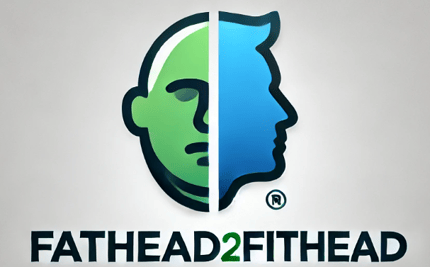CREATE YOUR OWN WEBSITE WITHIN 2 MINUTES USING AI WITH 20% OFF TODAY WITH HOSTINGER! 👉CLICK HERE!
The Mental Block Keeping You Fat (Fix This First)
🔥 The Shocking Reason You Can’t Lose Weight (It’s Not Your Diet or Exercise) You’ve tried every diet. You’ve sweat through countless workouts. You’ve white-knuckled cravings… only to fall back into old habits. But what if the real reason you’re struggling has nothing to do with food or fitness? What if there’s a hidden mental block—programmed into your subconscious—that’s sabotaging your progress? And what if fixing this one thing could finally unlock effortless, permanent fat loss? This isn’t another "eat less, move more" article. This is a deep dive into the psychology of weight loss, backed by neuroscience, behavioral studies, and real-world transformations.
LOSING WEIGHT EASILY
Philip DEVILLE
4/9/202524 min read


✍️ The Mental Block Keeping You Fat (Fix This First)
🧠 Full Article Outline:
🔹 Chapter 1: Why You’re Still Stuck – The Hidden Mental Weight
🔹 Chapter 2: The Most Common Mental Blocks That Sabotage Fat Loss
🔹 Chapter 3: The Subconscious Beliefs Making You Hold On to Weight
🔹 Chapter 4: Emotional Eating Isn’t a Habit – It’s a Message
🔹 Chapter 5: Your Identity Is Keeping You Fat
🔹 Chapter 6: The Weight of Guilt, Shame, and Fear
🔹 Chapter 7: How Society Shapes Your Weight Story
🔹 Chapter 8: Rewiring Your Brain for Fat Loss – A Step-by-Step Blueprint
🔹 Chapter 9: The “Breakthrough” Exercise (Fix It for Good)
🔹 Chapter 10: Beyond Weight – Becoming Who You Were Meant to Be
🔹 Conclusion: What Happens When You Finally Let It Go
🔥 INTRODUCTION: You Know What To Do, So Why Aren’t You Doing It?
You know the drill.
Eat less, move more, cut the sugar, drink more water.
You’ve read all the books, tried the diets, counted the calories, done the workouts.
You even had moments of progress.
But somehow… you’re back here again.
Frustrated. Stuck.
Maybe even heavier than before.
And you ask yourself:
“What is wrong with me? Why can’t I just lose this weight?”
Here’s the truth:
There’s nothing wrong with your body.
There’s something blocking your mind.
This article is not about willpower, motivation, or calorie math.
It’s about the mental block that’s quietly keeping you stuck, overweight, and exhausted—no matter how hard you try.
And once you see it and fix it…
Weight loss finally becomes natural, sustainable—and honestly? Effortless.
Let’s begin.
🧠 Chapter 1: Why You’re Still Stuck – The Hidden Mental Weight
You are not lazy.
You are not weak.
You’re not addicted to food.
But you are carrying weight that isn’t physical.
You’re carrying mental weight.
💥 The invisible load that never gets addressed:
Self-doubt: “What if I fail again?”
Fear of change: “Who will I be if I’m not overweight?”
Past trauma: “Food is my only comfort.”
Subconscious beliefs: “I don’t deserve to be happy in my body.”
These aren’t excuses.
They’re emotional anchors—and until they’re released, your body will resist change.
The Body Follows the Mind
Here’s a concept most fitness experts ignore:
Your body listens to your subconscious mind more than your conscious goals.
You may say you want to lose 30 pounds.
But if deep down your brain associates being thin with danger, rejection, or losing love…
It will do everything it can to keep you safe by keeping you overweight.
It sounds crazy. But it’s scientifically sound.
A True Story:
A client of mine, let’s call her Lisa, had tried every diet under the sun.
She worked with trainers, therapists, even underwent hypnotherapy.
Nothing stuck.
In one breakthrough session, she remembered how, at age 11, she was harassed by an older man while wearing a swimsuit.
Subconsciously, her brain decided:
“Being thin = unsafe.”
No diet could override that hidden program.
Only after we rewrote that belief was she able to lose 45 pounds in under a year—with no strict diet.
Her body followed her mind.
Key Truth: If your subconscious believes being overweight protects you in any way, it will sabotage every attempt to lose it.
🔒 Chapter 2: The Most Common Mental Blocks That Sabotage Fat Loss
You might think the problem is carbs, calories, or cortisol.
But the real saboteurs? They're hiding inside your mind—quiet, subtle, and powerful.
Here are the most common mental blocks that keep people fat, frustrated, and forever “starting over.”
1. “I Always Fail” Syndrome
Every failed diet becomes a scar. Eventually, it stops being “a plan that didn’t work” and starts being “I never work.”
This belief becomes self-fulfilling. The moment results slow down, you quit—because your mind says, “See? It’s happening again.”
✅ Fix: Keep a “victory journal” of every single win—not just pounds lost, but decisions made, workouts done, cravings conquered. You’re building self-trust, not just shrinking your body.
2. Fear of Success
Strange but true: many people fear what life might look like if they finally get fit.
Will I have to start dating again?
Will my partner get jealous?
Will friends treat me differently?
Will I be able to keep this up forever?
✅ Fix: Journal this prompt:
“What bad things might happen if I finally lose the weight?”
Once fears are written out, they can be challenged, reframed, and released.
3. Emotional Attachment to Food
For many of us, food = love.
Food = comfort.
Food = safety.
And we don’t want to give that up.
But emotional hunger is a hole that food can’t fill.
✅ Fix: Before reaching for food, ask:
“What am I really hungry for right now?”
Connection? Rest? Validation? Address the real need.
4. The All-or-Nothing Mentality
One bad meal? “I blew it, might as well binge all weekend.”
This is perfectionism in disguise.
✅ Fix: Replace “I messed up” with “I made a choice.”
Health is not perfection. It’s consistency.
5. Body Distrust
If you’re at war with your body, it will never feel safe enough to let go of weight.
✅ Fix: Write a forgiveness letter to your body.
Start treating it like a friend you’re learning to love again—not an enemy to punish.
🧠 Chapter 3: The Subconscious Beliefs Making You Hold On to Weight
Here’s something nobody tells you:
Your weight is not just physical.
It’s psychological.
And often… it’s protective.
You’ve been trained to believe fat is the enemy.
But what if it’s been your defense system all along?
In this chapter, we uncover the deep, invisible beliefs running in the background—controlling your habits, sabotaging your success, and anchoring you in a body that doesn’t feel like you.
🔍 What Are Subconscious Beliefs?
Subconscious beliefs are ideas you picked up without even realizing it.
They come from:
Childhood experiences
Comments from parents, teachers, or peers
Past trauma or painful memories
Cultural and societal messaging
Even things you overheard or saw on TV
They become the “rules” your brain lives by.
And here’s the kicker:
You’re not aware of most of them. But they still drive your actions.
Especially with your weight.
🧱 1. “I Need to Be Fat to Feel Safe”
This is one of the most common (and least talked about) subconscious beliefs.
You might consciously say, “I want to be fit.”
But if a younger version of you was bullied, sexualized, or hurt when you were thinner, your brain might believe:
“Thin = exposed.
Fat = safe.
Stay fat.”
Your brain isn’t trying to sabotage you.
It’s trying to protect you.
✅ Fix: Ask yourself:
“When did I first start gaining weight—and what was going on in my life at that time?”
Often, the gain began during a time of stress, trauma, or transition. Your body may have responded to an emotional threat by creating physical armor.
🧱 2. “I Don’t Deserve to Look or Feel Good”
This belief is soaked in guilt, shame, or low self-worth. Maybe someone made you feel “too much” when you were younger. Or maybe love was given only when you were “small” or “quiet.”
So now, when you try to look amazing, part of you pulls back—like you’re breaking some invisible rule.
✅ Fix: Rewire this by repeating:
“I am allowed to take up space.
I am allowed to be powerful.
I am allowed to feel amazing in my body.”
It’s not just affirmation. It’s mental reconditioning.
🧱 3. “If I Change, I’ll Lose My People”
This one’s sneaky.
If you grew up in a family or social circle where being overweight is normal—or even bonded you to others—losing weight might feel like betrayal.
You fear judgment, envy, or abandonment.
So your subconscious says:
“Better stay the same than be alone.”
✅ Fix: Ask:
“What am I afraid might happen if I become fit and healthy?”
This belief is based on survival—social connection is a basic human need. But true belonging never requires you to shrink who you are—literally or figuratively.
🧱 4. “Change Is Too Hard / I’ll Never Keep It Up”
If you’ve failed before, your brain doesn’t trust that change will stick.
So instead of risking disappointment again, it convinces you to stay in the comfort zone—even if it’s slowly killing your joy.
✅ Fix: Focus on micro wins.
1% better every day beats 100% perfect once a year.
Change isn’t overwhelming if you let it be gradual. The brain loves repetition and small success.
🧠 Why You Need to Rewire the Inner Story
Until you shift these inner beliefs, your brain will override your fitness goals.
It’ll skip workouts. Trigger cravings. Forget progress.
And you’ll call it “lack of discipline.”
It’s not that.
It’s just a subconscious script saying: “Don’t change. It’s not safe.”
“Your body is not broken. Your mind is not broken.
But your story may need a rewrite.”
We’ll dive into how to do that in the next chapter.
💬 Chapter 4: Emotional Eating Isn’t a Habit – It’s a Message
You don’t eat when you’re emotional because you’re weak.
You eat because you’re trying to feel something.
Or escape something.
Or numb something.
And the truth is, emotional eating isn’t your enemy.
It’s your messenger.
Once you learn how to listen, you’ll finally stop trying to fight your cravings—and start healing what they’re trying to say.
🍕 Emotional Hunger vs. Physical Hunger
Here’s how you tell them apart:
Physical HungerEmotional HungerComes on graduallyComes on suddenlySatisfied with any foodCraves specific foodsStops when fullEats past fullnessNo negative emotion afterFollowed by guilt or shame
If you recognize emotional hunger in your life, you're not alone.
It affects everyone—from stay-at-home moms to CEOs to personal trainers.
But again: it’s not a flaw. It’s a signal.
🧠 Why We Eat Our Feelings
From childhood, we’re taught:
“Don’t cry, here’s a cookie.”
“You’re upset? Let’s get ice cream.”
“You were good today? You earned a treat.”
We’re programmed to associate food with:
Reward
Comfort
Soothing
Celebration
So as adults, when life hits hard, we turn to the familiar: food = fix.
But food was never meant to solve emotions.
It was meant to fuel the body—not bury the soul.
🔄 The Cycle of Emotional Eating
You feel something uncomfortable: stress, sadness, loneliness, anxiety.
You eat to escape or soothe that feeling.
You feel guilty about eating.
The guilt creates more emotional discomfort.
You eat again to cope.
Round and round you go.
Sound familiar?
🚨 The Message Behind the Craving
Every time you crave food emotionally, your body is trying to say something.
Here’s how to decode it:
🍫 Craving Chocolate?
You might need comfort, connection, or love. Chocolate often represents emotional warmth.
🍟 Craving Fries or Chips?
You might need stimulation or excitement. Crunchy foods release stress through chewing.
🍞 Craving Bread or Pasta?
You might need calm and safety. These foods are grounding and tied to nostalgia.
This isn’t “woo.” It’s emotional pattern recognition.
Your cravings have a language. Learn to speak it.
🛠️ Fix: The 5-Minute Pause Practice
Before eating emotionally, do this:
Pause.
Put your hand on your heart.
Ask: “What am I really feeling right now?”
Ask: “What do I need right now—besides food?”
Choose to either meet that need—or eat consciously.
Even if you still eat, you’ve just turned an unconscious binge into a mindful moment. That’s a win.
❤️ Stop Trying to “Control” It – Start Listening to It
Willpower doesn’t work on emotional eating.
Why? Because your emotions are stronger than your logic.
Instead of forcing yourself to “resist,” practice curiosity and compassion.
Ask:
“What am I avoiding?”
“What am I trying to soothe?”
“What needs attention that I’ve been ignoring?”
Because here’s the truth:
You don’t have an eating problem.
You have a feeling problem.
Fix the feelings—and food stops being your therapist.
🔐 Chapter 5: Your Identity Is Keeping You Fat
If you’ve ever lost weight and gained it back…
If you sabotage your own success every time you start doing well…
If you feel like you’re living in a body that doesn’t match who you want to be…
Then it’s time to talk about identity.
Because no matter what you eat, how hard you work out, or how many plans you follow—you’ll never outperform the person you believe you are.
🤔 Who Do You Think You Are?
We all have an internal story—an identity we wear like skin.
That story sounds like:
“I’ve always been the big girl.”
“I’m not athletic.”
“I come from a family of heavy people.”
“I’m just not one of those ‘fit’ types.”
“I love food too much.”
This identity becomes comfortable, even if it’s painful.
Why? Because it’s familiar. Safe. Predictable.
Change—even good change—can feel like a threat.
And your brain LOVES the familiar more than it loves the idea of success.
🧠 Identity: The Real Set Point
Forget about metabolic “set points.”
The real weight set point is your mental image of yourself.
If you believe you are a person who struggles with weight…
If you see yourself as someone who will always “try again Monday”…
Then even if you lose weight, you’ll unconsciously sabotage yourself until you return to that identity.
This is why people often regain the weight they lose.
They didn’t just change their bodies—they needed to change their identity.
🪞The Identity Gap
Let’s say you want to be “fit and confident.”
But you currently see yourself as “overweight and stuck.”
There’s a gap between your current identity and your desired one.
That gap creates friction.
And the friction shows up like:
Missing workouts “just this once”
Eating junk after a win
Doubting compliments
Avoiding the mirror
Telling yourself “this won’t last”
It’s not that you’re broken.
You’re just living from an outdated story.
🛠️ Fix: Shift Identity First
Here’s the secret that elite athletes, high achievers, and real transformation success stories all have in common:
They became the person in their mind before they ever became it in real life.
You need to live as if you are already that person.
✅ Ask yourself:
“How would the future me—the one who is fit, free, and full of energy—make decisions today?”
✅ Start your mornings with:
“I am becoming the kind of person who…”
(e.g. "chooses food that nourishes me," "moves my body with pride," "believes in myself")
✅ Visualize:
Imagine your “transformed self” waking up, eating breakfast, going through a day. How do they walk? Talk? Move? Choose?
🧩 Why This Works
Your brain doesn’t know the difference between a vividly imagined identity and reality.
So if you consistently imagine yourself as already being that person…
Your thoughts, habits, and actions will automatically begin to match.
You become who you believe you are.
So believe better.
⚠️ Warning: Others Might Not Like It
When you start shifting your identity, some people will get uncomfortable.
Why? Because your growth forces them to confront their own lack of change.
You’ll hear:
“You’ve changed.”
“You’re obsessed.”
“One bite won’t kill you.”
“You were more fun before.”
Stay strong.
You’re not abandoning them—you’re becoming you.
🧠 Truth Bomb:
You don’t need to “fix” your weight.
You need to stop living like someone who’s broken.
You’re not broken.
You’re just becoming someone new.
😔 Chapter 6: The Weight of Guilt, Shame, and Fear
Not all weight is physical.
Some of the heaviest things we carry can’t be seen on a scale.
Guilt from past choices
Shame about how you look
Fear that you’ll never change
Fear that you actually will
These are the emotional anchors that silently drag your energy, motivation, and joy underwater.
And unless you release them, no amount of clean eating or cardio will create lasting change.
💣 Guilt: “I Messed Up Again…”
You promised yourself you’d eat clean today.
Then the donut happened.
And now guilt rushes in like a tidal wave:
“I blew it.”
“Why can’t I control myself?”
“What’s wrong with me?”
Here’s the truth:
Guilt is not motivation. It’s self-punishment.
And the more you punish yourself, the more your brain associates health with pain—which causes more self-sabotage.
✅ Fix Guilt: Use Curiosity Instead of Criticism
Next time you “mess up,” don’t say, “Why am I such a failure?”
Say:
“That’s interesting. What triggered me in that moment?”
“What was I feeling when I reached for that food?”
“What do I need to feel better next time?”
Treat yourself like a student, not a criminal.
You’re learning—not failing.
😞 Shame: “I Hate My Body”
Shame isn’t just about what you eat—it’s about who you think you are.
It whispers:
“You’re disgusting.”
“You’ll never be good enough.”
“Why even try?”
And unlike guilt (which says “I did something bad”), shame says “I am bad.”
Shame keeps you in the shadows.
It makes you skip the gym, avoid mirrors, refuse photos, and sabotage progress because… what’s the point?
✅ Fix Shame: Separate Who You Are from What You Do
Start saying this out loud:
“I am not my habits. I am not my past. I am someone in process.”
Speak to your body like it’s a child who needs encouragement—not a punching bag that deserves punishment.
“I’m listening now.”
“I’m learning how to love you.”
“I’m on your side.”
This is not just “positive thinking”—it’s neurological rewiring.
😨 Fear: “What If I Can’t Do It?”
Fear shows up in two ways:
Fear of failure: “I’ll try and fall short again.”
Fear of success: “What if I lose the weight and still feel empty?”
Fear paralyzes progress.
It keeps you planning, preparing, and “starting Monday”—but never doing.
✅ Fix Fear: Make Peace with Discomfort
Here’s a truth you need to tattoo on your mindset:
Growth is uncomfortable. Staying stuck is worse.
You don’t need to get rid of fear—you just need to stop letting it drive.
Say this:
“I can be scared and still move forward.”
“Fear is just energy. I choose where to channel it.”
Every time you act in the presence of fear, you’re retraining your brain to trust yourself.
💡 Emotional Weight Feeds Physical Weight
When guilt, shame, and fear go unprocessed, they trigger emotional eating, low motivation, body disconnect, and toxic self-talk.
But when you face these feelings?
✨ You eat with intention.
✨ You move with joy.
✨ You rest without guilt.
✨ You show up differently.
You stop losing weight to “fix” yourself…
And you start losing it because you’ve finally stopped carrying things that were never yours to hold.
You don’t just need a diet. You need emotional detox.
🏛️ Chapter 7: How Society Shapes Your Weight Story
Here’s something that rarely gets talked about:
Most of your thoughts about your body didn’t start with you.
They started with:
Magazine covers
Hollywood bodies
Childhood comments
Cultural “ideals”
Fitness influencers
Diet industry ads
Friends, family, and even doctors
From a young age, you were taught what “beautiful” looks like.
You were fed a blueprint of the “right” body.
And you were quietly conditioned to believe your worth was connected to your size.
This is not your fault.
But now it is your responsibility to break free.
💣 The Lie You’ve Been Sold
Society taught you:
“Thin is healthy. Thin is happy. Thin is lovable.”
And so you believe:
“If I lose weight, I’ll finally be confident.”
“If I look like her, I’ll finally feel good about myself.”
“If I get fit, I’ll finally be accepted.”
But this sets you up for failure.
Because confidence doesn’t come from a number on the scale.
It comes from alignment, ownership, and self-respect.
When your motivation is based on shame or social pressure, you’ll either:
Burn out trying to become someone else
Or lose the weight and still feel empty
🎯 How Culture Hijacks Your Self-Image
You don’t realize how much influence media has until you step back and observe it.
Everywhere you look:
Weight-loss ads promise happiness
Social media rewards “before-and-after” shots, not emotional healing
“Fitspo” glamorizes extremes
People compliment weight loss—even when it comes from illness or stress
You are constantly being told: “You are not enough—yet.”
So you stay in a loop of:
Fixing
Controlling
Shrinking
Comparing
Failing
Starting over
Not because you’re weak.
But because you’re being mentally manipulated by a billion-dollar industry that profits from your insecurity.
🧠 Your Brain on Comparison
When you compare yourself to someone online, your brain does something dangerous:
It says:
“She looks like that, and I don’t. Therefore, I am less.”
That comparison triggers:
Body hate
Guilt
Shame
Urgency to “fix” yourself
This emotional storm often leads to binge eating, crash dieting, or giving up altogether.
And it’s all based on a lie.
Because her body isn’t better—it’s just different.
Her life isn’t happier—it’s just filtered.
And your worth?
Unchanged. Always.
👩👧 Family Conditioning Runs Deep
Beyond media, your earliest body stories were written at home.
“You’d be so pretty if you just lost weight.”
“Are you sure you need seconds?”
“In our family, we just have big bones.”
“No man wants a fat girl.”
These comments—whether subtle or direct—become scripts your brain memorizes.
And the worst part? You might still be following those scripts, decades later.
🛠️ Fix: Rewrite the Story. Take Back the Pen.
The narrative society gave you?
Toss it.
It’s time to become the author of your own body story.
✅ Do this exercise:
Title: “What I Was Taught vs. What I Choose to Believe”
What I Was TaughtWhat I Choose to BelieveThin = worthyWorth is not tied to sizeI have to be perfect to be lovedI am lovable as I amI’ll never be fitI am becoming stronger every dayMy body is a problemMy body is a partner on my journey
Read this list every day for 30 days.
This is how you break brainwashing and rebuild truth.
🔥 Final Truth for This Chapter:
The more you accept yourself as you are,
The easier it becomes to change who you’re becoming.
Society shaped your weight story.
But you get to write the ending.
🧠 Chapter 8: Rewiring Your Brain for Fat Loss – A Step-by-Step Blueprint
Let’s be real:
You can have the perfect meal plan…
The best gym membership…
All the right supplements and macro calculators…
But if your mindset hasn’t changed, you’ll always fall back into old patterns.
Why?
Because your brain is a habit machine.
It doesn’t care what you want. It only cares what’s familiar.
So if your thoughts and identity haven’t been upgraded, you’ll eventually return to whatever your brain sees as “normal”—even if it’s misery.
This chapter is your breakthrough.
We’re going to walk step-by-step through a science-backed, soul-powered process to rewire your brain for weight loss success.
🛠️ Step 1: Identify the Old Program
First, you need to know what belief or habit has been running the show.
✅ Ask yourself:
“What thought or belief always leads me to give up?”
Common examples:
“This is too hard.”
“I always mess things up.”
“I’ll never look like them.”
“I’ve already failed, what’s the point?”
Don’t judge the answer. Just observe it.
Awareness is the first step to change.
🧠 Step 2: Interrupt the Loop
Your brain is wired to automate behaviors. That’s great… unless it’s automating bingeing, skipping workouts, or negative self-talk.
The goal is to interrupt that loop the moment it starts.
✅ Use a pattern breaker. Examples:
Clap your hands
Say “Cancel!” out loud
Stand up and stretch
Do 10 jumping jacks
Snap a rubber band on your wrist
You’re training your brain to pause before reacting. That pause gives you back your power to choose.
🧠 Step 3: Rewire with a Replacement Thought
You can’t just remove a thought—you have to replace it.
Pick one core belief you want to install, and rehearse it daily.
✅ Examples:
“I choose progress over perfection.”
“Every healthy choice rewires my identity.”
“I treat my body like someone I love.”
“I already am the kind of person who takes care of myself.”
Repeat this belief:
First thing in the morning
During moments of temptation
While looking in the mirror
Before every meal
Repetition + emotion = neurological rewiring
🔁 Step 4: Visualize the New You – Daily
Your brain is visual. It believes what it sees—even if it’s in your imagination.
✅ Visualization practice (3-5 mins/day):
Close your eyes.
Picture your ideal self walking into a room.
How do they move? How do they eat? How do they speak?
Feel the confidence in your body.
End by saying: “This is me. I am becoming this.”
This primes your brain to seek alignment with that version of you. That’s where real transformation starts.
📆 Step 5: Anchor Habits to Identity
Instead of thinking in terms of “goals,” think in terms of who you are becoming.
A goal says: “Lose 30 pounds.”
Identity says: “I am someone who nourishes my body.”
✅ Create daily identity-based habits:
Identity BeliefTiny Daily ActionI care for my bodyDrink 1 glass of water upon wakingI am active and strongDo 5 minutes of movement each morningI am worthy of restTurn off screens 30 minutes before sleepI eat to fuel, not numbJournal 2 minutes before meals
Tiny consistent actions shape identity.
Identity drives behavior.
Behavior sustains results.
💡 Step 6: Celebrate Early and Often
Your brain responds to reward, not punishment.
If you only focus on what’s not good enough yet, your brain will resist change.
✅ Create a “win tracker.”
At the end of each day, write 3 wins—no matter how small.
“I stopped eating when full.”
“I took a walk after dinner.”
“I said no to second helpings.”
“I forgave myself after a binge.”
“I showed up for me.”
Reinforcement builds momentum.
And momentum builds identity.
🔄 Step 7: Expect Setbacks (and Don’t Make Them Mean Anything)
You will mess up. That’s guaranteed.
The difference between people who transform and those who quit?
What they make the mess-up mean.
Losers say: “See, I always screw this up.”
Champions say: “That was just a blip. I’m still on track.”
✅ Reframe every slip as data, not disaster.
“Hmm. I binged because I skipped lunch.
Good to know—I’ll prep better tomorrow.”
This mindset turns failure into feedback—and that’s how you build a body (and life) that lasts.
🎯 Final Thought for This Chapter:
“If you want to change your body, don’t start with your food.
Start with your thoughts.”
Rewire your brain, and your body will follow.
🔓 Chapter 9: The “Breakthrough” Exercise (Fix It for Good)
Let’s pause for a second.
You’ve learned:
How your subconscious beliefs hold you back
Why emotional eating is a signal, not a flaw
That your identity shapes your behavior
And that your body follows your thoughts
Now it’s time to do something about it.
This chapter gives you a 15-minute exercise that has changed lives—not through willpower, but through clarity.
This is the part where the mental weight begins to lift.
🎯 The Goal:
To identify the one core belief keeping you overweight…
… and replace it with one that sets you free.
🧠 The “Breakthrough” Exercise
Grab a journal, or open a blank note on your phone.
Sit somewhere quiet where you won’t be interrupted for 15 minutes.
Let’s begin.
🪞 STEP 1: Ask Yourself the Real Question
Write this down and answer it honestly:
“If there was one hidden reason I’ve stayed overweight, what would it be?”
Don’t filter. Don’t sugarcoat. Don’t try to be “right.”
Common answers include:
“Being heavier makes me feel safer.”
“I’m scared to be seen.”
“Losing weight means losing who I’ve always been.”
“I don’t believe I deserve to be healthy.”
The first answer you write may not be the truth.
Keep digging until something clicks emotionally.
🔥 STEP 2: Write Out the Cost
Now write:
“What has this belief cost me?”
Examples:
“I’ve missed out on years of joy.”
“I’ve said no to dates, trips, opportunities.”
“I’ve lived in hiding.”
“I’ve punished my body for trying to protect me.”
This part hurts, and that’s good.
Because pain is the spark that makes the brain say: “No more.”
💡 STEP 3: Find the Truth Under the Lie
Now ask:
“What is actually true?”
You’re looking for the truth that will disarm the belief keeping you stuck.
Example:
Old belief: “I’ll never lose weight because I always quit.”
New truth: “Every time I’ve tried, I’ve learned. That makes me resilient—not weak.”
Old belief: “I don’t deserve to look and feel amazing.”
New truth: “I was born deserving. I’ve just been taught to forget.”
This isn’t positive thinking. It’s a mental jailbreak.
✍️ STEP 4: Write a New Identity Statement
Write a single, powerful statement that represents the version of you who’s already free.
Examples:
“I am someone who treats my body like a sacred home.”
“I am free from the beliefs that kept me small.”
“I am a fit, vibrant, confident version of me—and I love living this way.”
“I am not who I was. I’m who I choose to be.”
Repeat this out loud every day. Especially when you feel yourself slipping.
Make it your anchor. Make it your mantra. Make it your truth.
🧱 STEP 5: Burn the Old Story (Literally or Symbolically)
On a separate piece of paper, write your old belief—the one that’s been keeping you stuck.
Fold it.
Burn it.
Rip it.
Flush it.
Shred it.
Whatever feels ritualistic and freeing.
This is your symbolic declaration:
“This belief no longer runs my life.”
🌀 What Happens Next?
This exercise is not magic—but it is momentum.
It’s the first step of reclaiming your brain.
Repeat it anytime you feel stuck.
Make it a monthly ritual if needed.
Every time you do it, you get lighter.
Not just in body.
But in energy.
In clarity.
In self-respect.
🔑 Final Thought for Chapter 9:
“You were never broken. You were just believing a story that wasn’t true.
Now you know the truth. And now… you’re free.”
🌟 Chapter 10: Beyond Weight – Becoming Who You Were Meant to Be
Let’s end this with the truth no one tells you:
This was never just about weight.
Yes, you came here to figure out why you can’t lose fat.
Yes, we explored mindset blocks, subconscious patterns, emotional eating, and rewiring the brain.
But beneath all of that is something bigger.
This journey is about coming home to yourself.
It’s about becoming the version of you that was always waiting underneath the fear, the beliefs, the shame, and the stories.
And now… you’re ready to meet them.
🧍♀️ The You Beneath the Weight
There’s a version of you who:
Moves through the world with ease
Eats with joy and intention—not guilt
Exercises to express strength—not punish weakness
Wakes up excited and energized
Dresses in clothes that match your spirit
Looks in the mirror and smiles—for real
Sets boundaries with ease
Walks into a room and knows you belong there
That version already exists.
You’re not creating her. You’re remembering her.
🧠 You’re Not Changing—You’re Reconnecting
For so long, you’ve believed your weight defined you.
You’ve measured progress in pounds, inches, and pant sizes.
But what if you measured your success in:
Self-respect?
Freedom?
Energy?
Confidence?
Integrity?
Peace?
Because weight loss isn’t the prize.
You are.
🏹 The New Mission
From now on, your mission isn’t just to lose fat.
It’s to become:
Mentally clear
Emotionally safe
Physically energized
Spiritually aligned
Why?
Because when you operate from that place, your habits change naturally.
Not because you “should”… but because it feels good to treat yourself with love.
📌 What to Do From Here
Let’s ground this whole transformation with real, lasting action.
✅ 1. Reread Chapter 9's Breakthrough Exercise once a month.
Keep checking in with your story. The more you revisit it, the more you reinforce your truth.
✅ 2. Shift your focus from outcome to identity.
Every morning, ask: “How would my highest self show up today?” Then follow her lead.
✅ 3. Stop waiting for motivation—use momentum.
Do one thing today that aligns with your future self. Drink water. Take a walk. Say no. Sleep early.
✅ 4. Forgive yourself—for everything.
You’re not behind. You’re not broken.
You’ve been surviving the best you could.
Now you’re ready to thrive.
✅ 5. Speak to yourself like someone you deeply respect.
What you say becomes what you believe. What you believe becomes what you become.
🎤 Final Words
This isn’t the end. It’s the invitation.
You’ve been living with weight—on your body, your heart, and your mind.
But now you know:
What’s really holding you back
How to fix it
How to free yourself
And how to become the person who no longer needs the weight
This isn’t just about shrinking your body.
It’s about expanding your life.
So go live it.
Go be her.
She’s ready.
And so are you.
❓ Q&A: Fixing the Mental Block That’s Keeping You Fat
💬 Q: What is a “mental block,” and how does it actually keep me fat?
A: A mental block is a subconscious belief or emotional pattern that makes your brain resist losing weight. It’s like a hidden script saying:
“Being overweight protects me. Changing is dangerous.”
Even if you consciously want to lose weight, your subconscious will sabotage it unless you rewire that belief.
💬 Q: How do I know if I have a mental block around weight loss?
A: Clues include:
You keep starting over
You feel guilt or shame around food
You self-sabotage progress
You fear attention or change
You emotionally eat even when not hungry
If this sounds familiar, it’s not a lack of willpower—it’s a mindset loop that needs to be broken.
💬 Q: What’s the difference between emotional eating and just being hungry?
A: Emotional hunger is:
Sudden and intense
Specific (you crave certain comfort foods)
Not satisfied even when full
Followed by guilt or shame
Physical hunger builds gradually, is satisfied by any food, and stops when you’re full.
💬 Q: What’s the fastest way to shift my mindset?
A: Start with identity. Ask yourself:
“Who do I believe I am when it comes to my body, food, and health?”
Then shift that identity slowly with daily micro actions and affirmations.
Your body changes after your identity does—not before.
💬 Q: I’ve tried everything. Why would this work when diets haven’t?
A: Diets treat symptoms. This article helps you fix the source: your beliefs, identity, and emotional habits.
When you change your inner world, the outer world follows—without burnout, obsession, or shame.
💬 Q: Do I have to be perfect to lose weight?
A: Absolutely not. The “all or nothing” mindset is one of the biggest mental blocks of all.
Progress happens when you stop chasing perfection and start choosing consistency—even when you “mess up.”
💬 Q: Can this mindset work even if I have a lot of weight to lose?
A: Yes. In fact, the more weight you carry—physically and emotionally—the more powerful this mindset work becomes.
It gives you freedom, momentum, and the ability to finally trust yourself.
💬 Q: How can I reinforce the breakthroughs I’ve had from this article?
A: Great question! Do these:
Repeat the Breakthrough Exercise (Chapter 9) monthly
Visualize your future self every morning
Write and repeat an identity affirmation daily
Track wins instead of weight
Forgive setbacks fast and keep going
💬 Q: I want more support—what can I do next?
A: You can:
Reread this article whenever you feel stuck
Journal through each chapter’s prompts
Work with a mindset coach or therapist
Use AI tools to help visualize your transformation (see below!)
⚠️ Disclaimer:
This article is for informational purposes only and is not medical advice. Fasting and any diet changes may affect individuals differently. Always consult with a qualified healthcare professional before starting any fasting plan, diet, or weight loss program, especially if you have pre-existing health conditions or take medications. Results vary, and this content is based on personal experience and research. Your health and safety come first! 🚀🔥
(Some parts of this article was written with the help of AI to provide the most effective and well-researched tips.)
Written by Philip DEVILLE




















Support
Join our community for weight loss support.
DISCLAIMER
JOIN MY COMMUNITY NOW!
We are affiliates. It means that we might receive a commission if you ever buy a product on our website, with no extra cost for You of course.
These articles are for informational purposes only and is not medical advice. Fasting and any diet changes may affect individuals differently. Always consult with a qualified healthcare professional before starting any fasting plan, diet, or weight loss program, especially if you have pre-existing health conditions or take medications. Results vary, and this content is based on personal experience and research. Your health and safety come first! 🚀🔥
Thank You very Much!
© 2025. All rights reserved.
